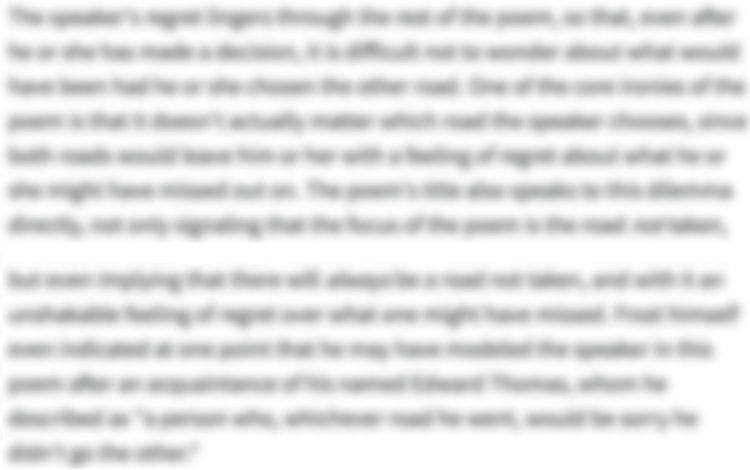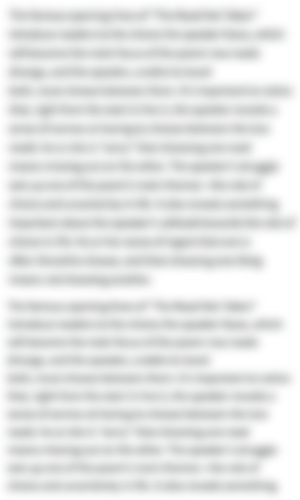The Full Text of “The New Colossus”
1Not like the brazen giant of Greek fame,
2With conquering limbs astride from land to land;
3Here at our sea-washed, sunset gates shall stand
4A mighty woman with a torch, whose flame
5Is the imprisoned lightning, and her name
6Mother of Exiles. From her beacon-hand
7Glows world-wide welcome; her mild eyes command
8The air-bridged harbor that twin cities frame.
9“Keep, ancient lands, your storied pomp!” cries she
10With silent lips. “Give me your tired, your poor,
11Your huddled masses yearning to breathe free,
12The wretched refuse of your teeming shore.
13Send these, the homeless, tempest-tost to me,
14I lift my lamp beside the golden door!”
-
“The New Colossus” Introduction
-
"The New Colossus" is an Italian sonnet written by the Jewish American poet Emma Lazarus. Lazarus was a passionate immigration activist, becoming particularly involved in the plight of Russian Jewish refugees. She wrote the poem in 1883 to help raise funds for the construction of the Statue of Liberty's pedestal, but the poem was not actually mounted on the pedestal until 1903. The poem compares the Statue of Liberty to the ancient Greek Colossus of Rhodes, presenting this "new colossus" as a patroness of immigrants rather than a symbol of military might. The statue's role and the poem's hopeful, unironic tone offer an idealistic vision of America's role on the world stage as a welcomer and protector of immigrants .
-
-
“The New Colossus” Summary
-
The speaker first describes what the New Colossus will not be like: the giant bronze statue of the sun-god Helios in ancient Rhodes. The Colossus of Rhodes was constructed to commemorate a military victory and was thought to stand with its legs on either side of a harbor. The speaker then moves from ancient Greece to America, describing the new statue’s position on America’s eastern shoreline. The statue looks like a powerful woman and holds a torch that's lit through the modern wonders of electricity. She is depicted as a motherly figure who welcomes immigrants to America. She does so through the guiding light of her torch and her gentle yet powerful gaze upon New York Harbor, which is sandwiched between New York City and Brooklyn (which were still separate cities when the poem was written).
The poem then gives the statue herself a voice. She speaks directly to the nations of Europe, telling them she wants no part of their showy displays of power. Though she is a silent statue, the speaker suggests that her symbolic message is clear. She goes on to command the ancient European nations to send its impoverished citizens—the thousands who long for freedom—to America. These people have been forgotten and rejected in their overly-populated countries with limited resources. Once again, she commands the ancient nations to send her those who have been exiled and battered by the storms of misfortune. She beckons these immigrants toward her with her torch, which metaphorically illuminates the entryway to America and all the opportunities it offers.
-
-
“The New Colossus” Themes
-
American Immigration
“The New Colossus” compares the Statue of Liberty to an ancient Greek statue, the Colossus of Rhodes. While the ancient statue served as a warning to potential enemies, the new statue’s name, torch, and position on the eastern shore of the United States all signal her status as a protector of exiles. Her protection extends both to the exiles who founded the United States, and to refugees hoping to make America their new home. When the speaker imagines the statue’s voice, the statue speaks directly to the “ancient lands” of Europe and claims its forgotten and rejected ones as her own. Each of these features contributes to the poem’s presentation of the Statue of Liberty as a symbol of welcome, and to the poem's broader message to embrace foreigners with open arms.
Through its description of two statues’ relationships to the land on which they stand, the poem offers contrasting ways of relating to one’s homeland and to foreigners. The first involves the “brazen giant” or Colossus of Rhodes, one of the Seven Wonders of the Ancient World. It was constructed to commemorate a military victory, and its “conquering limbs” were believed to have straddled a harbor. All foreign ships would have had to pass beneath its “brazen” or bronze legs and, in so doing, to contemplate the demise of the defeated soldiers from whose abandoned weapons the statue was made. This threatening stance served as a warning to approaching sailors and potential invaders. In contrast, the New Colossus stands firmly at the “sea-washed, sunset gates” of America. This lyrical image of America’s Eastern shore—the shore that faces Europe across the Atlantic Ocean—connotes a sense of openness to new visitors.
This sense of openness is confirmed in lines 4-8, in which the statue is called “Mother of Exiles” and her torch is described as a beacon. The Statue of Liberty's French sculptor included a torch to symbolize reason and liberty enlightening the world. In the poem, though, the torch instead glows for the same reason a lighthouse does: to safely guide travelers home. It is a “beacon” or sign of “world-wide welcome” to the thousands of immigrants arriving in New York.
The statue’s role as patron of immigrants is solidified when the sonnet's sestet (or final six lines) puts the new world’s guardian in direct conversation with the “ancient lands” of Europe from which they emigrate. The statue rejects the “storied pomp” through which European empires, such as those of ancient Greece, were founded and maintained. The Colossus of Rhodes was built from the abandoned bronze weapons of the defeated army of Cyprus. As such, it is a pompous display of power that highlights the victor’s story but obscures the suffering of the conquered people. The New Colossus commands the old lands to send its marginalized people, the “huddled masses,” to her. She will ensure that those who are “homeless” and long to “breathe free” will find refuge. The statue’s torch returns in the final line as a “lamp” that illuminates the “golden door” of American opportunity.
This golden promise of the Statue of Liberty, then, offers a tantalizing alternative to all that the ancient Colossus of Rhodes represented. The speaker hopes that the maternal statue and her promise of radical hospitality will become a symbol for America itself. In other words, the poem presents the Statue of Liberty as both part of America and representative of its values, and in so doing argues that America should be defined by its willingness to both accept immigrants and actively welcome them.
- See where this theme is active in the poem.
-
The Promise of Freedom
Since this poem was written to support a fundraiser for the Statue of Liberty’s pedestal, the poem implicitly invites readers to compare what the poem does say about the historical statue to what it does not say. Although the poem doesn’t use the statue’s formal name, “Liberty Enlightening the World,” it is deeply concerned with the statue’s understood connection to liberty and freedom. It suggests that the expansion of powerful ancient European empires—which were founded on principles of class and military power—deprived many people of personal and political liberty, and then has the statue voice a promise to restore that fundamental human right. “The New Colossus” represents an idealistic vison of nationhood in which a government’s power is used not to conquer, but to honor all people’s inherent dignity and right to liberty.
The octave, or opening eight lines of the sonnet, describes the political conditions under which freedom is either offered to all or restricted to some. It pits ancient structures of oppression against a new, American commitment to welcoming exiles. The Colossus of Rhodes, an ancient statue built after a military victory, is described as having “conquering limbs.” This majestic description thinly veils the consequences of war, in which the conqueror flourishes while the conquered are disenfranchised. The poem criticizes this political system by replacing this threatening statue with a welcoming yet “mighty” statue at America’s eastern shoreline (the shoreline that faces Europe across the Atlantic). In naming the new statue, the speaker does not reach outside the poem for its formal, historical title: “Liberty Enlightening the World.” The statue’s ties to Libertas, the Roman goddess of freedom, are thus obscured. In place of a classical image of liberty as political independence, the poem instead renames the statue “Mother of Exiles.” This title, along with the torch the statue raises to offer “world-wide welcome” to refugees, make this statue, and the nation on whose shore it stands, a guardian of all who wish to seek freedom in a new home. More broadly, the poem positions the statue as a "new colossus," which suggests that it is replacing the values of that old Colossus of Rhodes, and implies that these new values that America offers will replace the old militaristic and despotic forces of Europe.
However, when the word “free” finally appears in line 11, the immigrants called toward America’s shores don’t yet have the liberty they long for. Instead, the word is included as part of a command from The New Colossus that the ancient European lands release the forgotten people whose individual dreams have been crushed under the burden of oppression. They are the ones longing to “breathe free,” for their human rights have been degraded such that they are deemed “refuse.” The maternal statue claims these exiles as her own and promises to shepherd them through the “golden door” of opportunity. The implication is that, on American land, human rights are respected, and all are given the resources necessary to flourish. When the poem ends, though, the statue is left awaiting the refugees’ arrival. Her promise of freedom remains unmet. “The New Colossus” thus presents freedom as a worthy ideal that has yet to be achieved in the world outside the poem.
- See where this theme is active in the poem.
-
Patriarchal Values vs. Maternal Virtues
The poem stages a contrast between stereotypical masculine and feminine values, but then blurs the line between them. It describes the Colossus of Rhodes in terms of strength in battle—something typically associated with masculinity—and claims that the New Colossus will be different. It then describes the New Colossus in terms of both commanding strength and maternal mildness. While the ancient statue offered a display of military dominance and a warning to powerful enemies, the new statue is both mighty and mild in her message of motherly welcome. This blended use of gendered attributes to describe the new statue makes it clear that hospitality should not be seen as some kind of female-specific weakness, but rather as a strength of American society. In other words, the poem suggests that America needs both the power once associated with an all-male military and government, and the mild spirit of welcome once associated solely with women.
The speaker first describes what the New Colossus will not be like: the warlike and hyper-masculine Colossus of Rhodes, a statue of the Greek Titan sun-god, Helios. This ancient statue was “brazen” in two ways: it symbolized arrogance and strength, and it was built by melting down and re-forging enemies’ bronze weapons. The reference to the Colossus of Rhodes's “conquering limbs” in line 2 recalls the statue’s purpose: to celebrate a military victory against Cyprus. These displays of physical and martial strength were understood to typify masculine virtues valued by a patriarchal society, in which positions of power are held by men, and power is used to dominate others, both foreign and domestic.
Lines 4-7 then describe what the New Colossus will be like: a mild and mighty mother. Although the speaker first promises that this new statue will not be like the Colossus of Rhodes, the next lines show that she won’t be its polar opposite, either. In place of the powerful male god, the New Colossus is “a mighty woman.” If the ancient statue was built partly to warn off potential invaders, the New Colossus understands her role as guardian differently. She is a “Mother of Exiles” holding a torch as a glowing sign of “world-wide welcome.” If the ancient statue’s enormous legs straddled a harbor in the posture of a conqueror, the new statue can “command” a harbor equally well through her “mild eyes.” It becomes clear, here, that hospitality is not a gendered weakness, but a societal strength.
In the poem's final six lines, signs of feminine mildness continue to merge with masculine boldness. Though the statue is imagined crying out with “silent lips,” the message she silently conveys is nonetheless powerful and universally understood. Setting up one more contrast between the male and female statues, the New Colossus invites the “ancient lands” to keep their displays of power and instead entrust the powerless to her care. She will protect the “poor” and “homeless” and guide them toward the “golden door” of opportunity. She, in other words, will be a defender of the world’s weakest people, and offer them the resources needed to become strong. The statue’s gendered attributes offer a new kind of strength that, even in its pointedly peaceful purpose, rivals that of the ancient, male-dominated world and, the poem implies, will eventually replace it.
- See where this theme is active in the poem.
-
-
Line-by-Line Explanation & Analysis of “The New Colossus”
-
Lines 1-2
Not like the brazen giant of Greek fame,
With conquering limbs astride from land to land;The first two lines of “The New Colossus” introduce the inverse simile that gives the poem its title, as well as several of its most prominent stylistic qualities. In this half of the simile between two statues, the speaker makes an allusion to the ancient Colossus of Rhodes. The ancient statue, which celebrated a military victory over Cyprus and was built from the defeated army’s bronze weapons, was believed to have stood with its enormous legs straddling a harbor. The use of the word "brazen" to describe this ancient statue refers to the fact that it was made from bronze. But the word "brazen" also means "bold or shameless," which implies a negative connotation of this ancient statue. The description of the limbs as "conquering" also suggests that the statue stands not in welcome, but rather as a symbol of military might designed to strike fear into the hearts of foreigners.
These lines also demonstrate how the poem both conforms to and diverges from the usual iambic pentameter of its Italian sonnet form. Lines of regular iambic pentameter contain five iambs, each of which has one unstressed syllable followed by one stressed syllable. The second line of the poem follows this iambic pattern (the "quering" of "conquering" should be read as a single syllable, with a sound like "ring"):
With conquering limbs astride from land to land;
The poem's first line, on the other hand, immediately breaks from the norm by opening with a trochee (a foot consisting of a stressed syllable followed by an unstressed syllable) and ending with a spondee (a foot consisting of a stressed-stressed pattern):
Not like the brazen giant of Greek fame
The inverse simile and irregular meter of these first two lines are the first indications of the way that the poem's style mirrors and emphasizes its vision of America as both embracing and breaking from European tradition. Written in the form of an Italian sonnet, the poem directly connects to a long and illustrious European literary tradition. And yet in its first line, the poem refuses to follow the traditional meter of the Italian sonnet. Similarly, the inverse simile turns the original function of a simile on its head: rather than showing how two unlike things are in fact similar, the poem's simile will show how two seemingly similar things are in fact unlike each other. As the poem proceeds, these twists on traditional poetic tools will add up, and suggest ways that America itself has emerged from a European history and tradition, and yet also turns that tradition on its head in service of new—and, the poem, argues, better—values.
The alliteration and assonance that help give the poem a repetitive sound are also featured in these first two lines. The first line uses long “a” and “i” vowels in “brazen” and “fame,” “like” and “giant,” while the second line uses the short forms of those vowels in “land to land” and “with” “conquering,” and “limbs.” Between the two lines, four words begin with an “l”: “like,” “limbs,” “land,” and “land.” These two kinds of repetition overlap to create a network of corresponding sounds, one which gives the poem a sense of sonic continuity even as it argues for a radical departure from ancient values.
-
Lines 3-6
Here at our sea-washed, sunset gates shall stand
A mighty woman with a torch, whose flame
Is the imprisoned lightning, and her name
Mother of Exiles.

Unlock all 616 words of this analysis of Lines 3-6 of “The New Colossus,” and get the Line-by-Line Analysis for every poem we cover.
Plus so much more...
Get LitCharts A+ -
Lines 6-8
From her beacon-hand
Glows world-wide welcome; her mild eyes command
The air-bridged harbor that twin cities frame. -
Lines 9-10
“Keep, ancient lands, your storied pomp!” cries she
With silent lips. -
Lines 10-12
“Give me your tired, your poor,
Your huddled masses yearning to breathe free,
The wretched refuse of your teeming shore. -
Line 13
Send these, the homeless, tempest-tost to me,
-
Line 14
I lift my lamp beside the golden door!”
-
-
“The New Colossus” Symbols
-
The New Colossus
The New Colossus is the poem’s name for the Statue of Liberty. For France, which designed the statue and gave it to the fledgling United States as a gift, the statue was meant to honor America’s commitment to political independence and to honor the relationship between France and the U.S. The poem, however, significantly broadens the statue’s symbolic significance. The statue both physically stands at America’s Eastern shore and meets the gaze of all who arrive, and symbolically gestures toward this young nation’s willingness to welcome immigrants and look kindly upon all foreigners. As such, in the poem the statue takes on a world-wide appeal—and symbolizes a new view of the world, founded on dignity and opportunity—that moves beyond America’s connection to France alone.
In the octave that makes up the sonnet's first eight lines, the new statue’s symbolic meaning is described by contrasting it to a much older statue: the Colossus of Rhodes. While the ancient colossus’s “conquering limbs” represented a military victory and thus a threat to potential invaders, the new colossus’s torch and “mild eyes” represent her message of motherly welcome to all visitors. That the Statue of Liberty is described in the poem's title as "The New Colossus" further implies that the symbolic meaning of the new statue will replace that of the old, militaristic Colossus of Rhodes.
In the last six lines of the sonnet, called the sestet, this message of hospitality is stated even more explicitly when the statue is given a voice. The statue commands the ancient nations of Europe to send its exiles to the U.S., where she herself will show them the golden door of opportunity. In giving its major symbol this confident voice, the poem hopes to encourage readers to join their voices with Lady Liberty, to embrace this idea of both the statue and America, and to welcome the stranger.
- See where this symbol appears in the poem.
-
The Torch
The statue’s torch has a number of symbolic meanings, each of them tied to the guiding and life-giving capabilities of light. The torch is first presented as containing “the imprisoned lightning,” a phrase that references its electric bulb but also symbolizes the power associated with the Greek God Zeus’s lightning bolt. Esther Schor, a scholar who has studied Emma Lazarus and her work, suggests that the torch's symbolic resonances may also encompass “enlightened Jewish nationalism,” or support for the re-establishment of a Jewish homeland. In this poem, however, any culturally-specific undertones are folded back into its universal concerns. In the next line, the torch joins with the statue to create a “beacon-hand” that “glows world-wide welcome.” This line makes it clear that the torch glows for the same reason a lighthouse does: to guide travelers—all travelers—to safety.
The torch returns in the poem’s final line as a “lamp” that shines upon the “golden door” of American opportunity. Both of these phrases reference the creative potential of light—it literally illumines our path and figuratively helps us imagine what is possible. In a broad sense, the torch here symbolizes the golden promise of a better life in America, which beckons immigrants toward its shores.
- See where this symbol appears in the poem.
-
-
“The New Colossus” Poetic Devices & Figurative Language
-
Alliteration
Alliteration occurs in almost every line of “The New Colossus,” and serves a dual purpose. It helps create a sense of sonic continuity throughout the poem, but also helps set up strong contrasts between two statues and two continents. In the first part of the poem, for example, this dual purpose is achieved by using alliterative words to describe both statues, but repeating different consonants in the two descriptions. “L” is used most often to begin words describing the Colossus of Rhodes, while “s” and “m” are used often to begin words describing the New Colossus. In both cases, the emphasis placed on these consonants is greatly increased through the use of consonance.
Throughout the poem, but particularly in the third line, consonants also create a rhythmic sound that mimics waves crashing on the shore one after another. The sea both joins and separates the old world of Europe and the new world of the United States—it puts distance between them, but its vast expanse touches both continents. The alliterative phrase “sea-washed, sunset gates” emphasizes that connection.
In the last six lines of the sonnet, there are fewer examples of alliterative but distinct words (i.e. different words that share sounds). Here, however, the presence of words that share an initial consonant because they are the same word increases. Six words in the sestet begin with a “y,” but five of them are the word “your.” This shift, in which the repetition of sounds gives way to the repetition of words, a shift from alliteration to diacope, can be read as highlighting the statue’s righteous anger. She is less concerned with fashioning strings of harmonious sounds, and more concerned with deploying the tools of rhetorical persuasion.
- See where this poetic device appears in the poem.
-
Allusion


Unlock all 392 words of this analysis of Allusion in “The New Colossus,” and get the poetic device analyses for every poem we cover.
Plus so much more...
Get LitCharts A+ -
Anthropomorphism
-
Apostrophe
-
Assonance
-
Consonance
-
Diacope
-
Enjambment
-
Imagery
-
Juxtaposition
-
Metonymy
-
Simile
-
-
“The New Colossus” Vocabulary
Select any word below to get its definition in the context of the poem. The words are listed in the order in which they appear in the poem.
- Colossus
- Brazen
- Astride
- Sunset gates
- Imprisoned lightning
- Exiles
- Air-bridged
- Pomp
- Huddled masses
- Refuse
- Teeming
- Tempest-tost
- Golden door
Colossus-
A much larger than life size statue of a person or a god. The poem describes the Colossus of Rhodes and calls the Statue of Liberty a “new” colossus in its title.
- See where this vocabulary word appears in the poem.
-
Form, Meter, & Rhyme Scheme of “The New Colossus”
-
Form
“The New Colossus” is an Italian sonnet (also called a Petrarchan sonnet). Italian sonnets contain fourteen lines, and usually consist of an eight-line stanza called an octave followed by a six-line stanza called a sestet. The octave is broken into two four-line quatrains, while the sestet is broken into two three-line tercets. The poem follows these standard formal divisions:
-
Octave
- Quatrain
- Quatrain
-
Sestet
- Tercet
- Tercet
In a typical Italian sonnet, the formal divisions of the poem coincide with shifts in the poem’s argument or narrative. Most Italian sonnets set up a problem in the octave, while the sestet initiates a “turn” toward resolving that problem. Usually this problem has to do with an issue of unrequited love.
“The New Colossus” differs from a typical Italian sonnet in both of these respects. First, the "problem" it focuses on is not one related to romantic love, but rather to the suffering of exiles and immigrants hoping for a better life in America. Second, the problem and its potential resolution cannot be linked to the poem's formal divisions. There is a shift in focus between the sonnet’s octave and sestet, with the octave describing the New Colossus in relation to the Colossus of Rhodes, while in the sestet the new statue chastises the "ancient lands" of Europe and welcomes exiles. But it is not a shift from problem to solution.
Already in the octave, the statue’s role as “Mother of Exiles” is established, offering a potential solution to the problem of the exiles’ suffering and homelessness. But at that point in the poem the issue hasn't yet been stated explicitly. Only in the sestet is the problem stated (thousands of people treated like “refuse” and “yearning to breathe free”). Even in the poem's final two sentences, the statue both identifies the suffering that exists and offers to alleviate it.
In a sense, the change or “turn” in “The New Colossus” is already present in line one, where the speaker states that The New Colossus represents a radical departure from the ancient Colossus of Rhodes. The poem doesn’t need to spend eight lines stating the problem and six lines proposing a solution. Instead, it integrates both problem and solution into one extended discussion of the Statue of Liberty’s symbolic meaning for American citizens and hopeful immigrants.
-
Octave
-
Meter
Like most Italian sonnets written in English, “The New Colossus” falls into a meter of iambic pentameter. Each line of iambic pentameter can be divided into five “feet” consisting of one unstressed syllable followed by one stressed syllable. While most sonnets follow this meter precisely, though, “The New Colossus” follows this rhythm only roughly.
A signal of the poem's metrical irregularity comes in the first line, which begins with a trochee (a foot consisting of a stressed syllable followed by an unstressed syllable) and ends with a spondee (a foot consisting of two stressed syllables):
Not like the brazen giant of Greek fame
Showing that it can play by the rules when it pleases, however, the poem’s next line is in perfect iambic pentameter (though you do have to treat the "quering" in "conquering" as a single syllable to hear it):
With conquering limbs astride from land to land;
Lines in strict iambic pentameter can also be found in lines eleven, twelve, and fourteen. Each of the other lines replaces at least one iamb with a trochee or a spondee. Many of these spondees are formed because of the poem’s heavy use of hyphenated compound words like “sea-washed,” “world-wide,” and “air-bridged.” In these three cases, the words joined by a hyphen each contain one syllable, and each will be stressed when read aloud. These consecutive stresses result in a number of spondees throughout the poem, and even a few instances of consecutive spondees like this one:
Here at our sea-washed, sunset gates shall stand
While the poem’s meter is overall in iambic pentameter, then, the poem also draws regular attention to the multitude of trochees and spondees varying its rhythm. Perhaps this pro-immigration poem is suggesting that the melodious effect of metrical variation might be replicated through openness to a pluralistic society. Perhaps, too, the many spondaic compound words reference America as a great melting pot, where those from many lands and cultures join to form one nation. All stresses in these spondees, like all citizens of America, are equal.
-
Rhyme Scheme
Although an unconventional Italian sonnet in many respects, “The New Colossus” follows the form’s standard rhyme exactly:
ABBAABBACDCDCD
The poem also makes use of diacope and assonance near line endings, thereby heightening the impact of corresponding sounds in the rhyme scheme. Examples of diacope include “land to land” in line two, while instances of assonance include “shall stand,” “your poor,” and “breathe free.”
-
-
“The New Colossus” Speaker
-
The speaker of “The New Colossus” is an American with a distinct vision for America’s future and role on the world stage. The speaker refers to the shores of New York as “our” gates, describing its harbor and new statue in loving detail. This is no objective voice—the way the speaker describes the statue has political overtones. In lines one and two, the speaker explicitly states that the new statue’s purpose is different from that of an ancient colossus that celebrated a military victory. In lines four through eight, the speaker gives the statue the name “Mother of Exiles” and describes the statue's torch as a light guiding exiles toward their new home. The speaker clearly privileges compassion and hospitality over conquering might.
In the second stanza, the speaker seemingly introduces a second voice: that of the statue herself. The statue, too, presents herself as a motherly figure waiting to welcome immigrants to America. The direct correspondence between these two voices makes it apparent that the speaker has put words in the statue’s mouth. The voice of an inanimate statue becomes one strategy among many for the speaker to advocate for radical hospitality for immigrants. In other words, one can reasonably argue that the speaker in both stanzas of the poem remains essentially the same.
The speaker’s idealism and strident confidence in the American dream puts some distance between the poem’s speaker and its author. Although Emma Lazarus was actively involved in immigration activism, she also became disillusioned with some of the organizations she supported. Born into a wealthy Jewish family, Lazarus used her resources to help found the Hebrew Technical Institute, which provided vocational training to Jewish immigrants. She also volunteered with the Hebrew Emigrant Aid Society’s employment bureau. Later, however, she lost faith in this effort, and instead advocated for the creation of a Jewish homeland. Given this complicated history, perhaps the poem’s speaker might be said to voice Lazarus’s early and idealistic vision of what America could be, and to either precede or put aside her disappointment in what she came to see as its failings.
-
-
“The New Colossus” Setting
-
In line three of “The New Colossus,” it becomes clear that the poem's setting is the precise location where the Statue of Liberty stands: Liberty Island in New York Harbor. The poem describes “here” as the point where the statue stands at America’s eastern shore, or “sunset gates.” The poem also references how the statue looks outward toward “twin cities,” which have been interpreted as either New York and Brooklyn or New York and Jersey City. Either way, the setting does not shift very far. Just as the poem makes the Statue of Liberty representative of America and its inhabitants' values, the setting might also be broadened to include the country as a whole. The statue may stand at one particular “harbor,” but as the guardian of a “golden door,” it is one part of a larger entity: an entire nation founded on the ideals of liberty, justice, and opportunity for all.
-
-
Literary and Historical Context of “The New Colossus”
Literary Context
As citizens of a new country only recently founded, many 19th-century American writers sought to create a distinctly American literature. This project spans from James Fenimore Cooper’s celebrations of rugged frontier life to the American individualism of Walt Whitman’s poetry. Emma Lazarus’s poem "The New Colossus" both participates in this work and pushes against it. “The New Colossus” offers a vision of what America could be that involves rejecting ancient European ideas of military valor and class hierarchy, but that also involves welcoming exiles from Europe and other lands. In other words, this poem both embraces a unique American identity and insists that this identity encompasses many cultures.
The poem’s political concerns place it in the second half of Emma Lazarus’s career, during which time her activism intertwined with her literary activity. Though born into a wealthy Jewish family, Lazarus was uninterested in her own heritage until she read George Eliot’s novel Daniel Deronda. Eliot’s nuanced exploration of Jewish identity precipitated Lazarus’s own probing treatment of the theme in much of her later work. Lazarus scholar Max Cavitch suggests that, in “The New Colossus,” the statue’s lamp is a veiled reference to a quote from Daniel Deronda’s Mordecai. Mordecai, who advocates for the creation of a Jewish homeland, declares that Israel’s heritage beats in the pulses of the multitudes and must be made visible: “let the torch of visible community be lit!” In Lazarus’s poem, the specificity of Eliot’s image is broadened to a “world-wide” appeal. This lamp lights the way not just for Jews, but for all exiles. The poem shares its sense of humanity’s interconnected nature with Walt Whitman’s poem “Crossing Brooklyn Ferry,” which describes the speaker’s sense of connection to “men and women of a generation, or ever so many generations hence.” The poem may also have been influenced by Percy Bysshe Shelley’s “Ozymandias,” a famous sonnet written about a statue earlier in the 19th century.
“The New Colossus” has influenced many later poets, particularly those who use poetry to make political statements. However, not all later poets saw "The New Colossus" in a complimentary way. Poets such as Claude McKay implicitly criticize its starry-eyed idealism by undercutting ideas of American greatness or exceptionalism. Sylvia Plath’s “The Colossus” obliquely references the poem in a different way, by comparing another contemporary figure (the speaker’s father) to the Colossus of Rhodes. In that poem, the emphasis is on the irreparably broken state of the ancient statue, rather than its martial glory astride the harbor.
Historical Context
“The New Colossus” was written during a major wave of American immigration, spanning roughly from 1880 to 1920. Though many of these immigrants did successfully make a new home for themselves in America during this era, doing so was not easy. The boom in U.S. industrialization meant that more jobs existed than ever before. As thousands arrived seeking these opportunities, however, many Americans saw the newcomers as unwelcome competition. In addition to the growing anti-immigrant sentiment, immigration became further restricted at the federal level. Emma Lazarus penned “The New Colossus” just one year after the Chinese Exclusion Act of 1882 limited the immigration of Chinese laborers. Lazarus herself concentrated her efforts on the plight of the Jewish refugees, who were fleeing anti-semitic violence across Europe and particularly in Russia. She wrote a defense of these Russian Jewish immigrants for the Century Magazine, along with a series of articles from 1882 to 1883 called “An Epistle to the Hebrews,” in which she argued that Jews must receive a robust education and began to advocate for the creation of a Jewish homeland in Palestine. During this same period, she wrote “The New Colossus,” which describes the Statue of Liberty beckoning refugees toward U.S. shores. If the cracks had already begun to show in an idealistic image of America as welcoming mother—as the anti-immigrant sentiment of the time would seem to suggest—nonetheless Lazarus’s poem tried to restore it.
-
More “The New Colossus” Resources
-
External Resources
-
The Poetry Foundation’s Guide to “The New Colossus” — The Poetry Foundation offers an essay that serves as a poem guide to “The New Colossus.” It covers historical background, offers an analysis of the poem itself, and describes the poem’s influence on American culture.
-
Interactive Poem through Nextbook Press — This interactive poem has been annotated by Princeton professor of English Esther Schor, who published a biography of Emma Lazarus.
-
The Statue of Liberty-Ellis Island Foundation: “About the Statue of Liberty” — Learn more about the poem’s inspiration, the Statue of Liberty, on this foundation’s website.
-
History.com: Background on 19th century American Immigration — In this survey of pre-1965 U.S. immigration, you can learn about the waves of immigration occurring during the 19th century and read an introduction to federal immigration regulations.
-
Library of Congress: “The New Colossus” Read Aloud — Hear the acclaimed, Brooklyn-born contemporary poet Alicia Ostriker read “The New Colossus” aloud and offer commentary on it.
-
-













